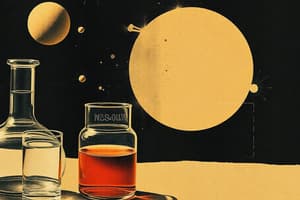Podcast
Questions and Answers
What is the primary difference between a suspension and a colloid?
What is the primary difference between a suspension and a colloid?
- The chemical composition of the particles
- The method of filtration
- The settling rate of the particles
- The size of the particles (correct)
What is the characteristic of strong electrolytes in solution?
What is the characteristic of strong electrolytes in solution?
- They conduct an electric current well. (correct)
- They produce few ions in solution.
- They are insoluble in water.
- They do not conduct an electric current.
Which of the following is an example of a strong electrolyte?
Which of the following is an example of a strong electrolyte?
- H2O2
- NaCl (correct)
- Oxygen
- Sugar
What is the unit of solubility?
What is the unit of solubility?
What is the primary characteristic of a nonelectrolyte?
What is the primary characteristic of a nonelectrolyte?
What is the key principle of solubility?
What is the key principle of solubility?
What is the primary difference between a solution and a colloid?
What is the primary difference between a solution and a colloid?
What happens to the components of a suspension?
What happens to the components of a suspension?
What type of compounds are usually soluble in water?
What type of compounds are usually soluble in water?
What is an example of a weak electrolyte?
What is an example of a weak electrolyte?
What is the term for the maximum amount of solute that can dissolve in a given amount of solvent?
What is the term for the maximum amount of solute that can dissolve in a given amount of solvent?
What type of compounds do not conduct an electric current?
What type of compounds do not conduct an electric current?
What is the molar mass of NaOH used in the calculation of molarity?
What is the molar mass of NaOH used in the calculation of molarity?
What is the conversion factor used to convert milliliters of solution to liters of solution?
What is the conversion factor used to convert milliliters of solution to liters of solution?
What is the unit of molarity?
What is the unit of molarity?
What is the formula to calculate molarity?
What is the formula to calculate molarity?
How many liters of solution are in 250 mL of solution?
How many liters of solution are in 250 mL of solution?
What is the molarity of the sodium hydroxide solution?
What is the molarity of the sodium hydroxide solution?
What is the concentration of a solution that contains 30 mL of 2-propanol in 120 mL of solution?
What is the concentration of a solution that contains 30 mL of 2-propanol in 120 mL of solution?
What is the unit of concentration that represents the number of moles of solute per liter of solution?
What is the unit of concentration that represents the number of moles of solute per liter of solution?
If a solution contains 0.5 g of solute in 100 g of solution, what is the concentration of the solution in ppm?
If a solution contains 0.5 g of solute in 100 g of solution, what is the concentration of the solution in ppm?
What is the concentration of a solution that contains 20 mL of solute in 100 mL of solution, if the density of the solution is 1.0 g/mL?
What is the concentration of a solution that contains 20 mL of solute in 100 mL of solution, if the density of the solution is 1.0 g/mL?
If a solution contains 2.5 g of NaCl in 250 mL of solution, what is the molarity of the solution?
If a solution contains 2.5 g of NaCl in 250 mL of solution, what is the molarity of the solution?
What is the maximum level of lead allowed in drinking water in units of ppm?
What is the maximum level of lead allowed in drinking water in units of ppm?
What is the concentration of a solution formed by diluting 5.0 mL of a 3.2 M glucose solution to 40.0 mL?
What is the concentration of a solution formed by diluting 5.0 mL of a 3.2 M glucose solution to 40.0 mL?
If 45 g NaCl is added to 150 grams of water, what is the resulting solution?
If 45 g NaCl is added to 150 grams of water, what is the resulting solution?
What is the molarity of a solution containing 117 g of potassium hydroxide (KOH) dissolved in 2.00 L of water?
What is the molarity of a solution containing 117 g of potassium hydroxide (KOH) dissolved in 2.00 L of water?
Which of the following is a step in solving a dilution problem?
Which of the following is a step in solving a dilution problem?
What is the unit of measurement that cancels out when solving a dilution problem?
What is the unit of measurement that cancels out when solving a dilution problem?
What is the ratio of NaCl to water in the solution described in the activity?
What is the ratio of NaCl to water in the solution described in the activity?
Flashcards are hidden until you start studying




